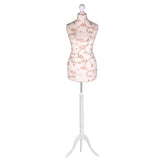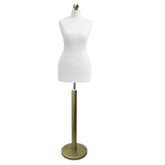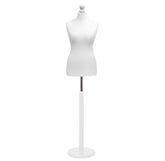The Ultimate Guide to Hanging Rails for Walls
Tired of bulky, space-hogging wardrobes? Wall-mounted hanging rails offer a sleek, elegant alternative. Think of them as a kind of floating shelf for your clothing – a strong, minimalist storage solution that frees up precious floor space and brings a clean, organised feel to any room.
Your Essential Introduction to Wall Hanging Rails
Picture turning a cluttered alcove into a streamlined open wardrobe, or transforming a blank wall into a chic retail display. That's the real magic of hanging rails for walls. Unlike traditional wardrobes that can dominate a space, wall-mounted rails have a tiny footprint. This makes them a brilliant solution for smaller UK homes, boutique shops, and anyone aiming for a minimalist interior. Their genius is in their simplicity and versatility.
This isn't just a niche trend, either. We've seen the use of wall-mounted rails in the UK grow by roughly 12% each year for the last five years. In fact, nearly 45% of homeowners now consider them a go-to option for clothes storage. This shift really highlights how much we're all looking for functional, adaptable, and stylish storage that works smarter, not harder.
Core Benefits at a Glance
The infographic below neatly summarises the three main advantages that make these rails so popular.
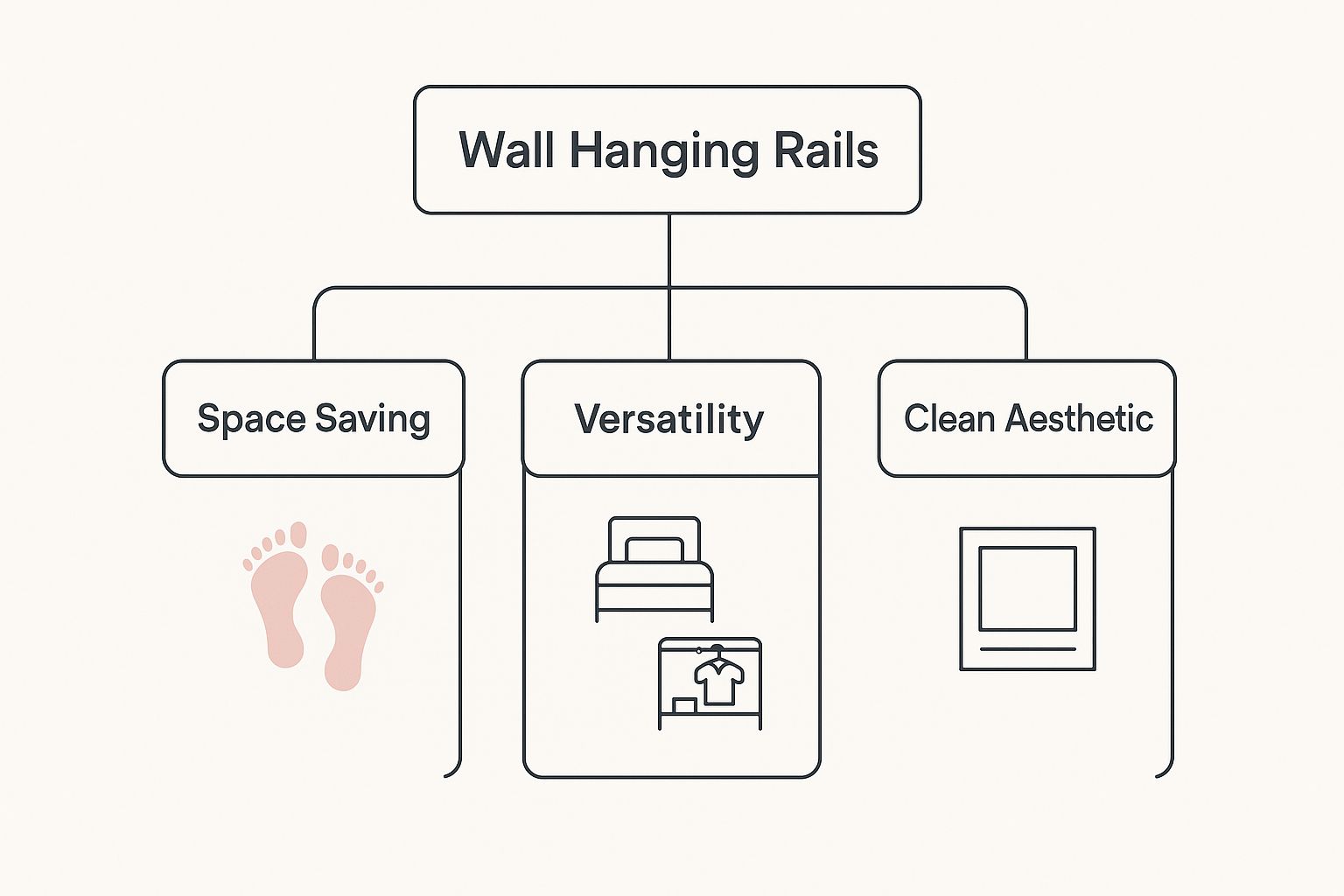
As you can see, the benefits all stem from the core concept of mounting the rail to the wall. It’s a simple change that delivers big improvements in space, versatility, and visual appeal. Whether you're a homeowner trying to declutter or a retailer wanting to create an inviting display, getting to grips with these benefits is the perfect starting point.
By lifting storage off the floor, you not only create physical space but also visual space, making rooms feel larger and less crowded. This principle is a cornerstone of effective interior design and visual merchandising.
The applications are incredibly broad. In a bedroom, a hanging rail can beautifully showcase a capsule wardrobe. In a hallway, it becomes a practical and stylish spot for coats and bags. For retailers, they are absolutely essential tools; you can see how they fit into a professional strategy in our guide on visual merchandising guidelines.
In this guide, we’ll walk you through everything you need to know to choose, install, and style the perfect wall-mounted rail for your space.
Exploring Different Types of Wall Hanging Rails
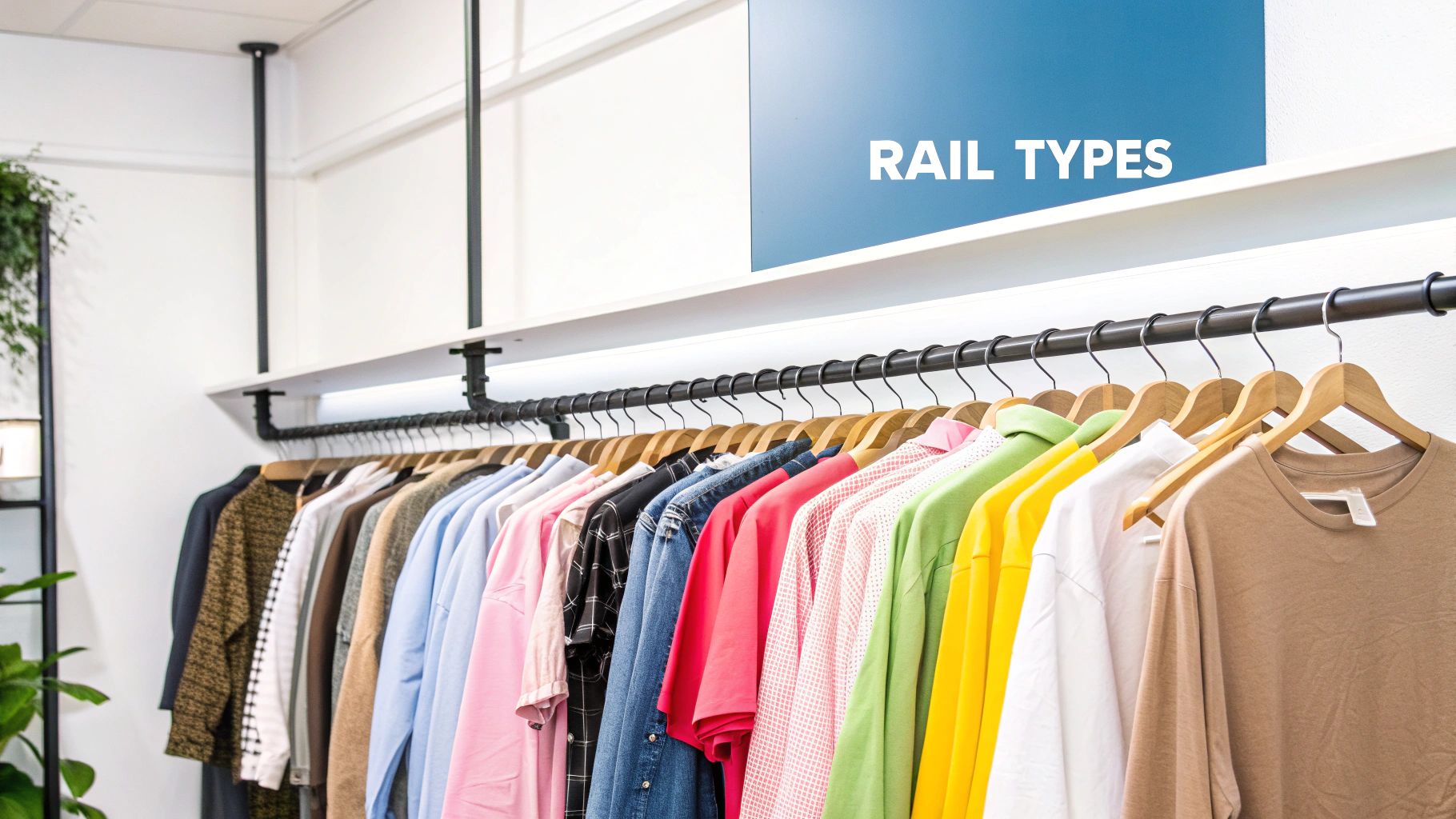
Choosing the right hanging rail for your walls is a bit like picking the perfect tool for a job. The best one really depends on what you want to achieve. Are you after simple storage or an elegant display? Luckily, the sheer variety available means there’s a perfect solution for every space.
Let’s dive into the most common options to help you find your ideal fit.
The most straightforward choice is the standard single rail. You can think of this as the dependable workhorse of wall storage. It’s simply a single bar held up by two brackets, giving you a clean, minimalist line that works brilliantly for everyday use in bedrooms, hallways, or laundry rooms.
When you need to get more from your space, the double-tiered rail is a fantastic upgrade. This design gives you two parallel bars, one stacked above the other, which instantly doubles your hanging capacity without taking up any extra wall width. It's an absolute game-changer in kids' rooms for separating school clothes from play clothes, or in a utility room for sorting laundry.
Specialised and Stylistic Rails
Beyond the basics, some hanging rails are designed to make a real style statement or serve a very specific purpose. These options can elevate a room's decor while still being incredibly practical.
One style that has really taken off is the industrial pipe rail. Usually made from black or galvanised steel pipes and fittings, these rails bring a raw, urban edge to a space. Their robust build also makes them exceptionally sturdy, so they're perfect for shops displaying heavy coats or for creating a modern, loft-style open wardrobe at home.
For ultimate flexibility, you have modular systems. These are fully customisable setups that can include multiple rails, shelves, and drawers that you piece together to fit your exact needs. They are the go-to solution for creating a bespoke walk-in wardrobe or a comprehensive stockroom display, letting you adapt the layout as your collection grows.
Finally, picture hanging rails offer an elegant and wonderfully flexible way to display artwork. Instead of drilling a new hole for every frame, these systems use a wall-mounted track with adjustable cords and hooks. This means you can change, add, or rearrange pictures effortlessly, all while keeping your walls pristine.
A well-chosen hanging rail does more than just hold items; it becomes part of your room's function and style. The right system can turn a cluttered wall into a feature of organised elegance.
To make the decision a little easier, here’s a quick comparison of the different types of hanging rails, looking at what they're best for and their key features.
Comparison of Wall Hanging Rail Types
| Rail Type | Best For | Typical Load Capacity | Aesthetic Style | Installation Level |
|---|---|---|---|---|
| Single Rail | Everyday clothing storage, minimalist bedrooms | Moderate | Minimalist, Versatile | Straightforward |
| Double-Tiered Rail | Maximising space, children's rooms, small flats | High | Functional, Practical | Straightforward |
| Industrial Pipe Rail | Heavy garments, retail displays, urban decor | Very High | Industrial, Modern | Moderate |
| Modular System | Walk-in closets, bespoke storage solutions | Varies (High) | Customisable, Contemporary | Advanced |
| Picture Hanging Rail | Art galleries, homes with evolving decor | Low (per hook) | Elegant, Traditional | Moderate |
Each rail type has its moment to shine. A simple single rail might be all you need for a guest room, while a full modular system could be the answer to your walk-in wardrobe dreams. It's all about matching the rail to the room and the job at hand.
How to Select the Right Materials and Finishes
Choosing the right material and finish for your hanging rails for walls is about more than just picking something that looks good. It's a decision that impacts the rail's strength, its lifespan, and the entire feel of your space. Think of it as choosing the perfect frame for a cherished piece of art – it needs to be both functional and complementary.
Industrial Cool vs. Sleek Modernity
If you're after a clean, contemporary look, stainless steel is a fantastic choice. It's naturally resistant to rust, making it ideal for steamy environments like bathrooms or utility rooms where other metals might struggle. Its sleek finish is professional, durable, and a breeze to keep clean.
For something with a bit more grit and an urban edge, you can't go wrong with black iron or industrial pipe. This is a seriously robust option, perfect for busy retail spaces or for making a statement in a loft apartment. That raw strength means it can handle a lot of weight, from heavy winter coats to a full-on clothing collection. If you need something that can take some serious punishment, our guide on selecting a heavy-duty wall mounted clothes rail has some great pointers.
From Classic Elegance to Natural Warmth
For a touch of luxury, brass is hard to beat. Its warm, golden hues bring a timeless elegance that can instantly elevate a boutique or a bedroom. You can keep it polished for a bright, reflective shine or let it age naturally for a more subtle, vintage feel.
And of course, there's wood. Nothing quite matches the natural warmth and texture it brings into a room. It’s incredibly versatile, fitting in everywhere from rustic farmhouse kitchens to minimalist Scandinavian homes. If you're leaning towards wood, it's worth getting to grips with different types and treatments, like understanding the advantages of pressure treated timber to ensure it lasts.
Your rail’s finish is the final touch that ties everything together. A matte black powder coat creates a contemporary look, a polished chrome finish feels bright and modern, while a brushed metal finish can hide fingerprints and wear.
It's no surprise that these smart storage solutions are becoming more popular. The UK home storage market has been growing steadily, and by 2023, sales of wall-mounted hanging rails accounted for around 18% of all wardrobe hardware sales. That's a huge jump from just 11% back in 2010, showing a real shift towards storage that is both stylish and space-savvy.
Getting to Grips with Load Capacity and Wall Suitability
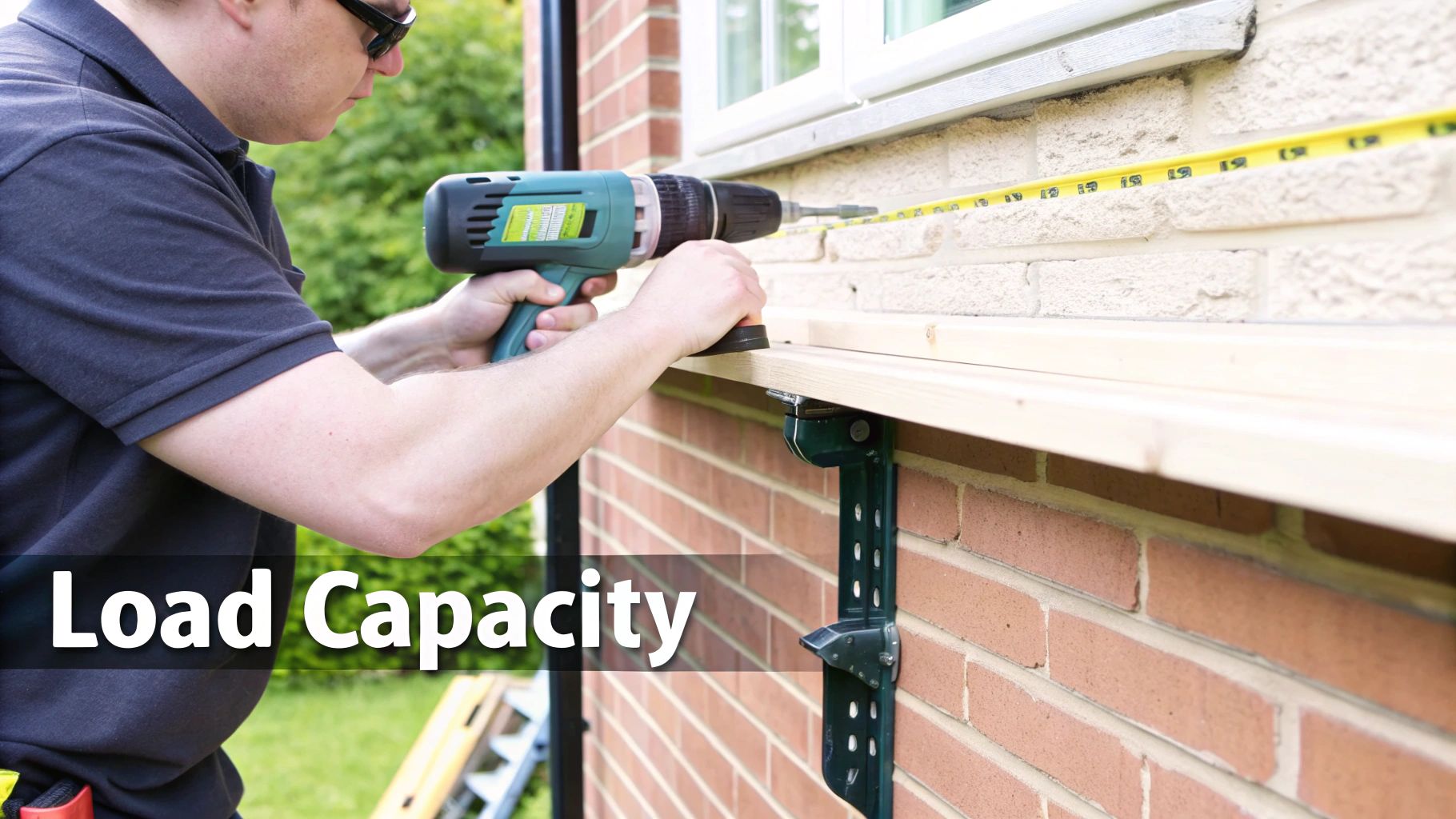
Before you pick up a drill, let’s talk about the two most critical factors for a successful installation: the weight your rail can handle and the strength of the wall you’re fixing it to. It's best to think of the rail and the wall as a team – one can't do its job without the other. Even the sturdiest rail is destined to fail if it's attached to a weak wall.
Getting this pairing right from the start is what stops your new display from coming crashing down, taking your prized collection with it. The manufacturer’s load capacity is your baseline, but always remember that figure assumes a perfect installation into a solid wall.
Matching the Right Fixings to Your Wall
In the UK, you’re likely to come across one of three main wall types in your home or shop. Each one needs a very specific kind of fixing to safely secure hanging rails for walls. Figuring out which one you have is the most important first step.
- Plasterboard (Drywall): The most common internal wall in modern buildings. Standard screws just won't cut it here; they'll pull straight out. You'll need specialist plasterboard fixings, like hollow wall anchors or spring toggles, which cleverly expand behind the board to spread the load.
- Brick or Blockwork: These solid masonry walls are fantastic for hanging heavy loads. You'll need a masonry drill bit to create the hole, followed by sturdy wall plugs and screws to get a really secure grip.
- Concrete: The strongest of the lot, concrete provides an incredibly solid anchor point. Much like brick, it demands a powerful drill and specific concrete screws or anchor bolts for an unbreakable hold.
The number one reason for installation failure is a mismatch between the fixings and the wall material. Always double-check what your wall is made of before you even think about buying or installing your rail system. It’s the key to a safe and long-lasting setup.
The impressive strength of these systems is a big part of their appeal. Many of the modern wall-hung rails available in the UK can comfortably support loads of up to 40-50 kg per linear meter. That often far exceeds what a freestanding alternative can handle. You can delve into more data on the growing hang rail market to see why they've become so popular.
Your Pre-Installation Safety Checklist
Don't leave anything to chance. A few minutes of planning now can save you a world of headaches later. Just run through this quick checklist to make sure your installation is built to last.
- Assess the Load: Be realistic about the total weight of the items you plan to hang. A rail full of heavy winter coats and denim is a completely different challenge from one holding light summer shirts. If you're dealing with a particularly heavy collection, it might be worth checking our guide on choosing a heavy-duty clothing rack.
- Identify Your Wall: Give the wall a firm tap. A hollow sound almost certainly means plasterboard, whereas a solid thud points to masonry. If you’re still unsure, drill a small test hole in a spot that won't be seen later.
- Check for Obstructions: This is a crucial step. Use a stud finder or a multi-detector to scan the area for hidden pipes, electrical cables, or wooden studs behind the wall. Drilling into one of these can be both dangerous and expensive to fix.
- Select the Right Fixings: Based on your wall type and the total estimated weight, choose high-quality plugs, anchors, and screws designed for the job. Never rely on the basic, often flimsy, fixings that sometimes come in the box with the rail.
Your Step-by-Step Installation Guide
Feeling a bit daunted by the idea of installing your own hanging rail? You’re not alone, but it's more straightforward than you might think. With the right approach and a little preparation, you can get a secure, professional-looking result you can be proud of. We'll break the process down into simple, manageable steps.
The golden rule for any DIY project is an oldie but a goodie: measure twice, drill once. Following this simple mantra will save you from misplaced holes and a lot of frustration down the line. Before you even think about drilling, get all your tools together so everything is within easy reach.
Preparing for a Perfect Installation
A smooth installation always starts with good preparation. Just taking a few moments to get organised will make the whole job quicker and easier.
- Gather Your Tools: You’ll need a tape measure, a spirit level, a pencil, a drill with the correct bits for your specific wall type, and the right wall fixings.
- Mark Your Positions: Decide on the best height for your rail. Use your tape measure and spirit level to mark precise, level spots on the wall where the brackets will go. A faint pencil mark is all you need.
Here's a great tip from the pros: stick a folded piece of masking tape to the wall just below where you plan to drill. It creates a small 'shelf' that cleverly catches most of the dust, saving you a big clean-up job afterwards.
Securing Your Hanging Rail
With your marks in place, you’re ready for the main event. This is where your careful planning pays off, ensuring your hanging rails for walls are perfectly straight and incredibly secure.
The most crucial part of this process is ensuring the brackets are perfectly level. An uneven rail isn't just visually distracting; it can also cause hangers to slide to one end, creating an unbalanced and potentially unsafe load.
Now, carefully drill pilot holes on your pencil marks. If you're fixing into plasterboard, gently tap your wall anchors into place until they are flush with the wall. For brick or blockwork, insert your wall plugs.
Finally, line up your brackets with the holes and securely screw them into the fixings. Once both brackets are firmly attached, you can place the rail on top and lock it in place according to the manufacturer's instructions. To keep everything in top shape, it's always wise to follow good general installation and maintenance practices.
With your new rail installed, you're ready to get organising! For more inspiration on different types and styles, you might find our overview of wall-mounted hanging rails helpful.
Creative Styling Ideas for Your Wall Rails
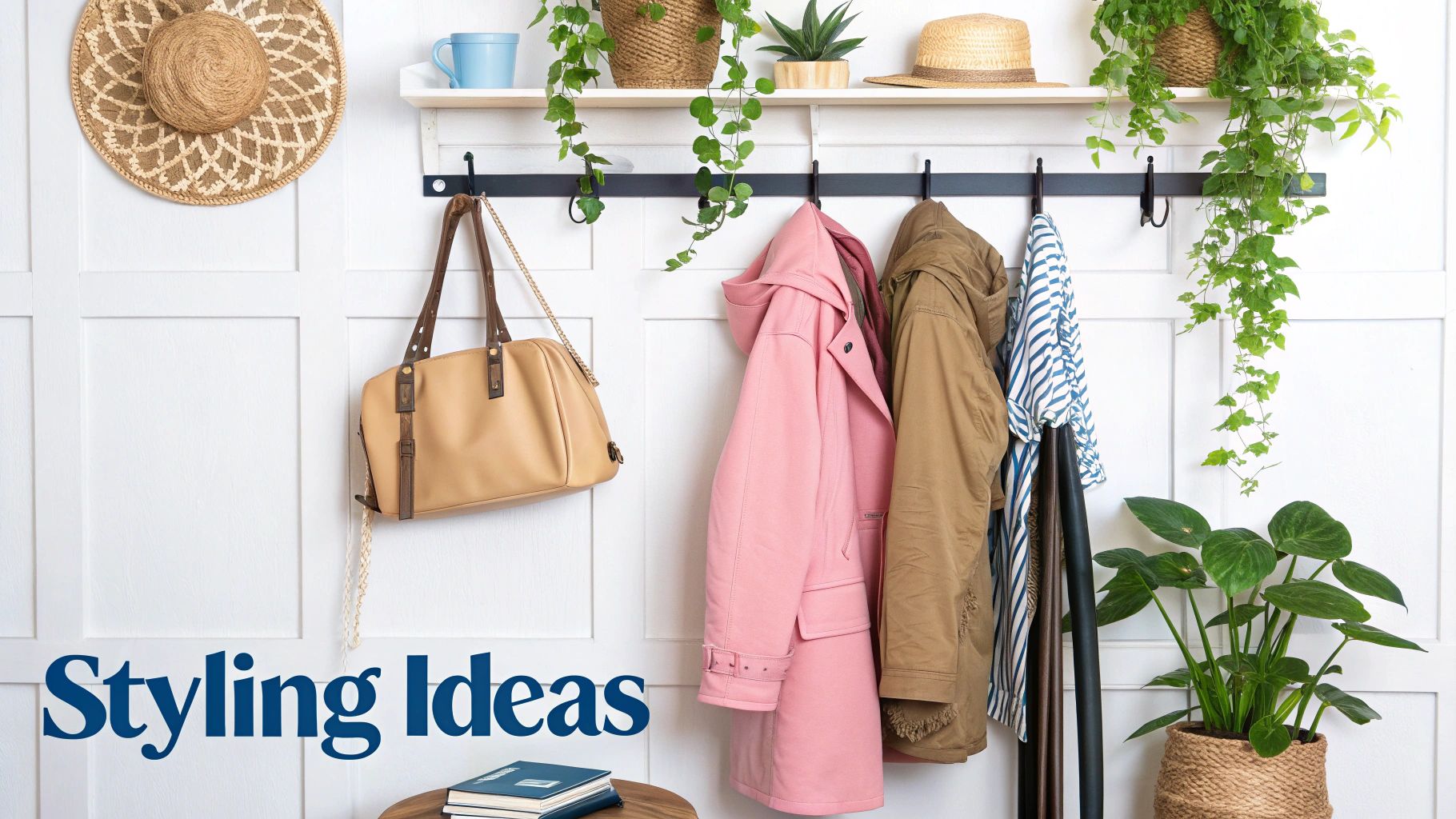
A hanging rail is so much more than just a place to store things. Think of it as a blank canvas, ready for you to make a statement and show off your personal style. With a little creativity, you can turn a simple rail into a stunning design feature that elevates any room in your home or shop.
Don't just hide your best pieces away in a wardrobe. Use your rail to create a curated display. This works especially well in a bedroom, where you can showcase a capsule wardrobe. By choosing items in a complementary colour palette, you’ll create a cohesive, boutique-like feel that’s both organised and genuinely inspiring to look at every day.
The beauty of this open-display concept is its versatility; it can be adapted for all sorts of spaces.
Beyond the Bedroom Wardrobe
Moving beyond clothes, hanging rails for walls can solve practical and aesthetic challenges all over the house. Their clean, functional elegance can be put to work in some surprisingly creative ways.
- The Kitchen Organiser: Pop a rail above your worktop to hang utensils, pots, and pans. Not only does this free up precious drawer space, but it also lends a professional, chef’s kitchen vibe to the room.
- The Entryway Station: Create a chic and welcoming entrance hall by mounting a rail for coats, scarves, and bags. For a complete look, pair it with a slim shelf above for keys and post.
- The Living Room Greenhouse: Use stylish S-hooks to suspend trailing plants like ivy or pothos from a rail. This instantly creates a beautiful living wall feature, bringing a welcome touch of nature indoors.
By integrating a rail with other elements, such as reclaimed wood shelves or metallic accents, you can create a look that feels intentional and fully integrated into your existing decor.
Mixing different textures and functions is the secret to making your display truly stand out. For retailers, this idea is central to creating dynamic visuals. You can find more inspiration by exploring different shop display ideas designed to capture customer attention.
Your Top Questions Answered
Even with all the details covered, a few questions always pop up. Let's tackle some of the most common queries about hanging rails so you can get started with total confidence.
Can I Really Put a Heavy-Duty Rail on a Plasterboard Wall?
Yes, absolutely—as long as you use the right fixings. This is probably the number one worry for anyone with modern walls, but it’s easily solved. Standard screws and plugs just won't cut it; they'll pull straight out of the plasterboard once any weight is applied.
The secret is to use specialised plasterboard fixings. Things like hollow wall anchors, spring toggles, or GripIt fixings are designed to open up and grip the board from behind. This spreads the load across a much wider area, giving you a surprisingly strong anchor point that can handle some serious weight.
How Do I Figure Out How Heavy My Clothes Are?
You don’t need to get the bathroom scales out for every T-shirt! A good rule of thumb is to plan for around 10-12 kilograms per 30cm (one foot) of rail. That’s a decent estimate for a mix of everyday clothing.
- Lighter stuff: Think shirts, blouses, and summer dresses.
- Heavier items: This is your denim, chunky knitwear, and winter coats.
If you know the rail is going to be packed with heavy items—like a collection of leather jackets or bulky winter coats—it’s smart to err on the side of caution. Just assume a higher weight and make sure your rail and fixings are more than up to the task.
Are Wall-Mounted Rails a Good Idea If I’m Renting?
They can be a fantastic, space-saving option for renters, but the golden rule is to talk to your landlord first. Because you’ll need to drill holes, you must get their permission before you start. Many landlords are perfectly fine with it, especially if it's installed well and improves the room.
To keep things smooth, you could offer to fill and paint over the holes when you leave. Using better quality fixings often means fewer holes, which makes the final patching-up job much easier. Always get any agreement in writing to avoid headaches down the line.
It’s clear these systems are becoming more popular. The UK market for wall-mounted hanging systems was valued at around £120 million in 2024, and it’s only set to grow. It’s a trend that makes perfect sense for modern living where every inch of space counts. You can discover more insights about the hanging system market on dataintelo.com.
Ready to get your space organised with a storage solution that’s both stylish and practical? At Display Guru, we have a huge selection of high-quality garment rails for any home or shop. Take a look at our collection and find the perfect match for your walls.


